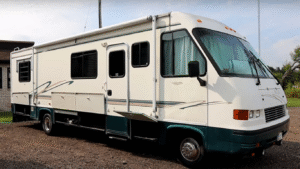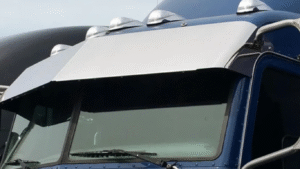Yes, you can tint your windshield in Arizona — but only to a certain extent. The law allows tinting on the top portion of the windshield (usually the top 5 inches or up to the AS-1 line), and that’s it.
Now, if you’re in Phoenix, this question makes total sense. With how intense the sun gets here — especially during summer — a bit of tint can help reduce glare, block UV rays, and make your driveway more comfortable. But before you rush into it, you’ll want to know what’s actually allowed and what could land you a ticket.
In this guide, we’ll break down what the law says, why people in Phoenix choose to tint, and what could happen if you go too far with it. Simple, legal, and practical — that’s the goal.
Is Windshield Tinting Legal in Arizona?
Yes — but only on the top part of your windshield.
According to Arizona Revised Statutes §28-959.01, you’re allowed to apply non-reflective tint above the AS-1 line, which is usually the top 5 inches of your windshield or the space just above the rearview mirror. Anything lower than that? Not legal.
Why this rule? It’s all about visibility. Full windshield tints can block your view, especially at night or during rain, and that’s a major safety concern. Law enforcement also needs a clear view inside the car during traffic stops.
If you’re wondering about tint laws for your side or rear windows — or whether red or mirrored tints are okay — we’ve got a full breakdown in our legal tint limits guide for Phoenix.
Why People Tint Windshields in Phoenix
Let’s be real — if you live in Phoenix, you know how brutal the sun can be. We’re talking 110°F+ days where even touching your steering wheel feels like grabbing a frying pan. That’s exactly why many drivers consider tinting their windshields — even just the legal top strip — to make driving more bearable.
Here’s why it actually helps.
1. Blocks Harmful UV Rays
A good quality windshield tint can block up to 99% of UVA and UVB rays. Why does that matter? Because those rays don’t just age your skin — they can increase the risk of skin cancer, especially for people who drive long hours. Even the Skin Cancer Foundation backs this up.
According to Healthline, UVA rays penetrate deeper and contribute to skin aging and cancer, while UVB rays cause sunburn and direct DNA damage.
2. Protects Your Car’s Interior
UV rays don’t just mess with your skin — they also fade your dashboard, crack leather seats, and warp plastic trims. A tint helps cut that damage by blocking the sun’s harshest rays. That means your car stays looking newer for longer.
3. Reduces Glare While Driving
We’ve all been there — blinded by sunlight during an early morning or late afternoon drive. That glare can be dangerous, reducing visibility and reaction time. A tinted upper strip on the windshield helps filter that harsh light so you can focus on the road, not on squinting.
4. Keeps the Cabin Cooler
Tinting also helps block infrared (IR) radiation — the stuff that makes your car feel like an oven. Some films reduce cabin temps by up to 15°F, even with just a partial windshield tint. That means less stress on your AC and quicker cool-downs when you start driving.
Practical stat: In Phoenix, parked cars can reach 150°F inside. IR-blocking films help fight that heat buildup.
What Happens If You Illegally Tint Your Windshield in Arizona?
If you go beyond the legal limit when tinting your windshield in Arizona, it’s not just a slap on the wrist — it can lead to real trouble.
Here’s what you’re risking:
1. You Can Get Pulled Over
Arizona law is clear: anything below the AS-1 line (or the top 5 inches) is off-limits. If an officer notices illegal tint while you’re driving — especially during a routine traffic stop — you could be cited on the spot.
Police use tint meters to measure VLT (Visible Light Transmission), so saying “it looked light enough” won’t help.
2. You Might Face Fines or Mandatory Removal
If your tint violates Arizona Revised Statutes §28-959.01, you can be fined. The exact amount can vary by county, but in many cases, you’ll also be required to remove the tint and bring your car in for re-inspection.
3. You Could Fail Your Vehicle Inspection
If your windshield tint doesn’t meet legal standards, it can lead to a failed inspection — especially when transferring a vehicle title or registering an out-of-state car in Arizona.
4. It Might Affect Your Insurance
In some cases, illegal modifications — including overly dark tints — can be flagged by insurers if you’re involved in a claim. For example, if illegal tint is found to have contributed to reduced visibility in an accident, your claim could be delayed or even denied.
According to Policygenius, unauthorized car mods can impact how insurers assess risk and coverage — and may lead to higher premiums or exclusions.
Is It Worth the Risk?
Not really. The Arizona sun is intense, yes — but you can still legally tint the top portion of your windshield for some sun relief. And if you need more protection due to medical reasons, Arizona does offer medical exemptions (we’ll touch on that in another post).
Conclusion: Stay Legal and Cool in Phoenix
So, can you tint your windshield in Arizona? Yes — but only the top portion above the AS-1 line is legally allowed. It’s a smart move for sun protection and glare reduction, especially in Phoenix’s intense heat, but it’s just as important to stay within the law to avoid fines or insurance issues.
If you’re thinking about getting your windshield tinted or need help after receiving a citation, it’s a good time to check the condition of your auto glass too. Whether you need a windshield repair in Phoenix, a full windshield replacement, or want expert advice from a trusted auto glass shop near you, we’re here to help. We also offer fast and reliable car windshield replacement services that ensure your vehicle meets Arizona’s legal standards.
Ready to stay safe, cool, and compliant? Get in touch with our team today for expert service in Phoenix.
Frequently Asked Questions
Can you use a clear ceramic film on the entire windshield in Arizona?
Yes, but only if it doesn’t reduce the visible light transmission below the legal threshold and remains non-reflective. Clear ceramic films that block heat and UV but don’t darken the glass may be permitted — but it’s best to check with a certified installer to avoid legal issues.
How do I know if my current windshield tint is legal in Arizona?
You can use a tint meter (available at some auto shops) to check the VLT percentage. Alternatively, many tint shops in Phoenix offer free legal compliance checks for existing tint jobs.
Will out-of-state vehicles with darker windshield tints be ticketed in Arizona?
Yes, Arizona law applies to all vehicles operated within the state, even if they’re registered elsewhere. If your tint doesn’t meet local standards, you could still get pulled over or cited.
Do factory-tinted windshields need to meet Arizona law?
Factory glass often comes with a slight tint that’s already compliant. However, any additional aftermarket tint — even if it’s light — must follow Arizona’s AS-1 line rule for windshields.
Can windshield tint help with migraines or light sensitivity?
Yes, for some people, tinting reduces glare and bright light triggers. This is why Arizona allows medical exemptions for conditions like photophobia or lupus. A doctor’s certification is required to apply for this through the Arizona DOT.
Does legal windshield tinting affect night driving visibility?
If done correctly and kept above the AS-1 line, legal tinting shouldn’t negatively affect your night driving. Overly dark or full windshield tints, however, can significantly reduce visibility in low-light conditions — which is a safety concern.
How long does legal windshield tint typically last in Phoenix heat?
High-quality films can last 5 to 10 years, even in extreme Arizona conditions — especially ceramic or nano-ceramic tints. Cheaper dyed films, on the other hand, may bubble or fade much faster due to intense sun exposure.





